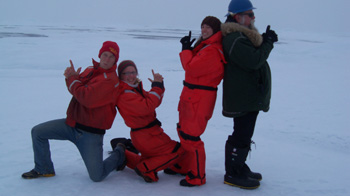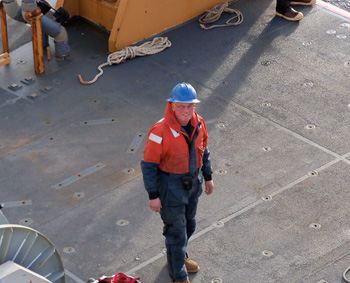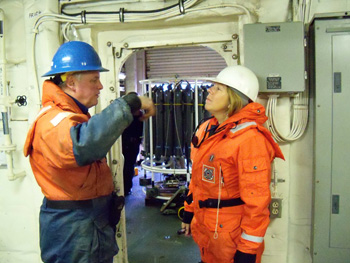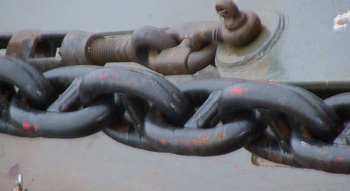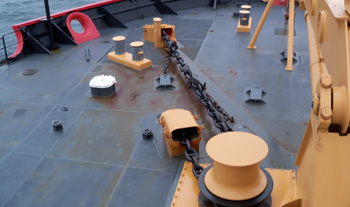QUESTION 1 WHAT DO YOU DO ON THE SHIP FOR FUN (BESIDES BINGO)? Answered by Pat Keoughan, Outreach: The people aboard who are involved with science have found quite a few ways to have fun. Perhaps the most "Arctic" type of fun is getting together to enjoy the natural wonders of this place. Most work stops and you'll find us hanging over the railings with cameras or binoculars looking at the ice floes, whales, icebows, auroras, polar bears, occasional C130 fly by and of course the spectacular sunrises and sunsets when the weather cooperates. In the Science Lounge, (See Happy Hollow's first 6th grade answer for more information.), I've seen people playing computer games, reading, playing cards, or just enjoying a lively conversation. The greatest attraction in that room has been watching movies. One group, all set with popcorn from the Mess, has watched 11 James Bond movies. (Some of them were made a long time ago and a lot of laughs are heard during the suspenseful scenes.) There are two gyms aboard and some people run around the decks. (We were told how many laps around certain areas equal a mile.) Exercise classes are offered for the Coast Guard which we can attend. Answered by Ensign Nicholas Custer, US Coast Guard: Each Saturday is morale night onboard. The evening starts with morale dinner. A group of crew members will volunteer to cook dinner, which gives the galley staff a break and always makes for a fun atmosphere. After dinner we have bingo and a movie in the hangar. In the hangar, we have a big screen, fancy projector, and powerful sound system. Sometimes we can get new movies from the Navy so we can show movies in the hangar up in the Arctic while they are still in theaters back in the states. The morale committee also sponsors all sorts of other events. So far this summer we have had two basketball tournaments on our hoop in the hangar, a ping pong tournament, several pig roasts and cookouts, and two casino nights. The most popular event we sponsored was a raffle for a plane ticket from our last port call in Juneau Alaska back to Seattle. The winner will arrive home six days early to spend time with his family, the best morale of all.The key to all our morale events is to keep people busy and get their minds off of work. We hold quite a few competitions because friendly competition is always a good way to work off some stress. Along those lines regular exercise is great way to relieve stress. We have three very nice gyms, a cardio gym, a weight gym, and an aerobics gym. This summer several groups have organized scheduled workouts to help motivate each other to stay healthy. At the end off each summer, we have the unique opportunity to bring family and friends onboard the cutter for a three day trip from Juneau, Alaska to Seattle. Our family and friends stay in the science party berthing areas and have an opportunity to see what it is like for their loved ones to sail onboard Healy. QUESTION 2 HAVE YOU HAD ANY STORMS? Answered by Pat Keoughan: The answer is, no. We have been lucky because very rough weather would interfere with the deployment and retrieval of the science instruments. We have had fog and light rain. We even went through some snow squalls along the route, but no storms. As I write this, we are steaming for Dutch Harbor in the Aleutian Islands of Alaska where our trip will end. We were just told the Healy will be arriving there a day earlier than planned. The reason is a storm, similar to a hurricane, which is due to hit Dutch Harbor the day we were supposed to arrive and the Captain wants to be in port before that happens. (Dutch Harbor is where Deadliest Catch is filmed.) Since weather forecasts can change, we have also been told to "secure" our belongings, including our computers. That means, make sure they are put away or tied down so that if we do get into the storm things aren't sliding around and falling. That will make the Healy safer for everyone if it gets rough. So, my no answer may turn to a yes before the cruise ends.
QUESTION 3 WHO HAS BEEN ON THE MOST SEA RESEARCH TRIPS IN THEIR JOB? Answered by John Kemp, Senior Mooring Tech.: I started at the Woods Hole Oceanographic Institution (WHOI) in 1978 at the age of 19 after attending Massachusetts Maritime Academy and Bridgewater State College for two years. Four days after being hired at WHOI, I was off to San Diego, California for seven weeks on my first research cruise. I pretty much knew instantly that this was something special, I had found my career path! After 33 years at WHOI, I still enjoy traveling and going to sea. On a typical year I'm scheduled to participate in 8 -10 research cruises which vary in duration. On average, I spend approximately 150 to 200 days a year at sea. I have been very fortunate to see parts of the world that one normally would not have the opportunity to visit. After this cruise, I'm back home for a short period of time before flying to Kaohsiung, Taiwan to join another research cruise.
QUESTION 4 IS IT WARM ON THE SHIP? Answered by Pat Keoughan: If Mrs. Buscher asks you right now who is a little chilly, who thinks the temperature is just right and who is feeling warm, I'll bet at least one person raises their hand for each choice. As I asked my shipmates, I got a whole range of answers. Most people feel it is often cool, especially at night. I have found if I dress in layers I'm comfortable if it's chilly and if I get overheated going up and down the ladders, I can take off some layers. The temperature on the boat is comfortable if we dress appropriately for it. (At least one scientist, Emily Schroyer says she's had goosebumps most of the time since the trip began.)
QUESTION 5 CAN YOU DESCRIBE A TYPICAL DAY ON AN ICEBREAKER? Answered by Pat Keoughan: (Farkenham High School's answer to question 3 will explain that some people have different "typical" days.) I can tell you what a typical day has been like for me. I set my alarm so I can be up for breakfast which is served from 7AM to 8AM. (To make sure I get enough sleep and don't get sick, sometimes I sleep through breakfast and get up at 9AM.) As soon as I'm ready for the day I go to the back of the ship (aft) where the science labs and computers are. Usually everyone is working on one of our projects or another. The meals really bring us together. Lunch is from 11AM to noon and I expect to see most of the science people there. Then we return to our “jobs”, many of us interacting with the others during the day. It is not like an office, each person makes their own work schedule. If there is a mooring being deployed, ice being broken by the Healy or whales are sighted we stop what we're doing, if we want to, so we can watch what's going on. There is a lot of learning going on from each other onboard, and from the Arctic itself. Dinner is from 5PM to 6PM and again, I see most of our group during that hour. After dinner many of us go back to finish what we've been working on. For most of this trip it has stayed light very late so I can work late and still get some daylight time to myself. Each individual, who is not on watch, decides when they are finished for the day. Many of us end up in the science lounge for some social time as we finish up. I like to do Sudoku for a while, write in my journal and chat or read a book. People go to bed when they feel like it. One change to this is Saturday mornings when everyone, Coast Guard and science, have a "field day" which means we clean our cabins, labs, lounge, halls, "heads" (bathrooms) and bring all our garbage to the recycling van on the deck. With over 100 people living aboard it is very important to keep the Healy clean for the sake of everyone's health. There are no maids aboard, so everyone pitches in to clean up. We have an early dinner which is usually good “junk food” items like fries, onion rings, hamburgers. (Our last Satrday night there was a chili cookoff.) Everyone's worked up an appetite by the end of the day. There is also a movie shown in the helicopter hangar to end the day. Of course the Coast Guard people are working around the clock to keep the Healy running, on track, broken things fixed, clean, people fed, assisting with the science, and keeping us all safe. They are on a watch system so they have work time and free time. They also have regular safety drills and some of them are even taking courses aboard.
QUESTION 6 WHAT HAVE YOU ACCOMPLISHED THAT YOU HAVE BEEN WORKING ON SO FAR? Answered by Emily Shroyer, Microstructure Oceanographer: With the help of many people here on the Healy, I was able to measure how the water mixes as it flows in a current along the coast of Alaska. This information will tell us something about how heat and nutrients are moved up and down through the water column. Answered by Josh Jones, Marine Mammal Researcher: Josh, the whale researcher, with a quick update on what we accomplished for my part of the science mission. Most importantly, we recovered two of three sound recording instruments (called HARPs) from the Arctic seafloor, got a year's worth of data out of them, replaced the batteries, and sent them right back down to the bottom to record for another year. We also deployed 35 sonobuoys, little hydrophones that float away from the ship and send their sounds back by radio. We didn't hear many marine mammals along the way, but sometimes having no detections can tell us things too. Thanks for following along down there. Maybe someday one or more of you will go to the Arctic on a research expedition of your own! Answered by Sharon Nieukirk, Marine Mammal Biologist: Hello Morse Pond 5th graders! This has been a very challenging trip for me because I actually had 2 very different jobs. The first was to retrieve and deploy hydrophone moorings (the undersea recording microphones you've been hearing about) and with the help of many others on our team that went very well. We got 4 moorings back (Yea! That doesn't always happen - sometimes the moorings decide to ignore our acoustic ping to release them.) and I put three new ones in the water. (These will be retrieved next year during a different cruise.) My second job has been to stand watch on the bridge of the ship and record all the marine mammals I see. This job was a little tougher. Many days I did not see any whales or seals. You would think looking at nothing all day would be easy but I assure you it is not. However, this information, no observed whales or seals in the area, is still useful when determining how animals use these Arctic waters. Yesterday my patience paid off and we saw lots of whale blows and even a feeding gray whale very close to the ship! I am still watching for marine mammals as we approach Dutch Harbor but I can say with confidence I have accomplished both of my assigned tasks while aboard the Healy. Answered by Craig McNeil, Chemical Oceanographer: We've already accomplished our main goal which was to drop a sensor package into the ocean to measure dissolved oxygen and carbon-dioxide. It had to be dropped at just the right location. The expert mooring and ship crews hit the spot perfectly! Answered by Bob Pickart, Chief Scientist: I think you can tell from the above answers and from following along on the website that, overall, the cruise has been tremendously successful for everyone onboard. Yes we had a few setbacks, for example one of Josh’s whale moorings didn’t come back and it looks like a polar bear destroyed my weather station! (please read the journal entry by Dallas Murphy called “Owners of the Ice” to learn more about that). However, we successfully deployed 9 moorings, put 7 floats into the water, occupied 172 CTD stations, and much more. From my own perspective I was thrilled to put a mooring in Barrow Canyon for the first time, and I never imagined that we would sample Amundsen Strait using the CTD. I can also tell you that we retrieved a huge amount of valuable data from the big mooring that we recovered. I have enough data now to keep me busy for years to come!
QUESTION #7 WHAT IS THE LARGEST WHALE YOU'VE SEEN? Answered by Sharon Nieukirk: The largest whale I’ve seen was a humpback, about fifty feet long. We could see its blow and flukes.
QUESTION # 8 WHEN ARE YOU COMING BACK? Answered by Pat Keoughan: The Healy is due to arrive in Dutch Harbor on Sunday, September 26, 2010 at 7PM. The group of us from Woods Hole will spend two nights aboard the Healy, then, if the weather permits, will fly to Anchorage, Alaska on the 28th and from there start the long trip back across the United States to arrive in Falmouth on the 29th.
QUESTION #9 AT THIS RATE HOW LONG WILL IT TAKE FOR THE ICE FLOES TO MELT? Answered by Pat Keoughan: The Arctic is still a cold place most of the year. No one knows when or if the Arctic ice will melt and never come back. There is a rhythm to the melting and freezing of the ice through the seasons each year. The ice reached its smallest amount for 2010 while we were here. (See the answer to Blakely School's question 6 by Matt Glazewski for more on the "annual minimum extent".) While we were in the ice, it was clear that melt ponds, melt water that pools on top of the ice, were freezing again, after 9/15/10.
QUESTION #10 HOW MUCH DOES THE ANCHOR WEIGH? Answered by Pat Keoughan: This was a burning question on many of our minds as we watched the process of pulling up the anchor that held the Healy in place while we were boarding by helicopter from Barrow, Alaska. It took about 45 minutes to raise it using winches. We found out it weighed 12,000 pounds! I asked Coast Guard Bosun Jon Placido for more information. There is a second 12,000 pound anchor that is for backup in case something happens to the main anchor. The main anchor has eleven shots of chain, the back-up anchor has ten. A "shot" is 90 feet of chain. You can figure out the total length of the two chains. That's not all, each link of chain weighs about 100 pounds! It makes sense that so much weight would be needed to keep a ship as large as the Healy in place.
Anchors are used on the science end of the ship, too. Every mooring we deploy needs an anchor to hold it on the correct spot on the bottom so tides and currents (and buoyancy) can't move it. According to John Kemp the heaviest mooring anchor for this cruise is 3,000 pounds. Last updated: September 29, 2010 | |||||||||||||||||||||||
Copyright ©2007 Woods Hole Oceanographic Institution, All Rights Reserved, Privacy Policy. | |||||||||||||||||||||||
